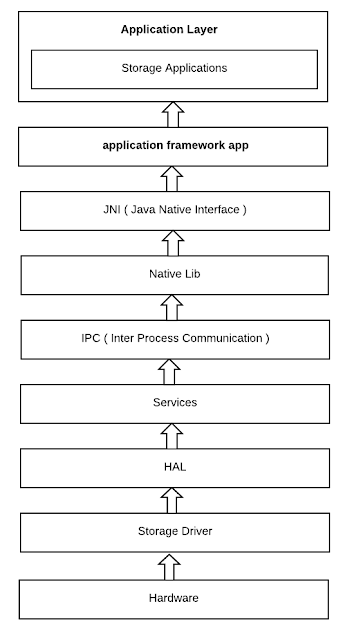please like & Subscribe our youtube channel
https://www.youtube.com/playlist?list=PLQzJncZC8PUwCTcniu_akzp0N0oDx7l1n
ROM DRM Architecture
The Android platform
provides an extensible DRM framework that lets applications manage
rights-protected content according to the license constraints associated
with the content. The DRM framework supports many DRM schemes; which
DRM schemes a device supports is up to the device manufacturer.
 |
| android ROM DRM Architecture |
Application Layer
Application layer contains many android apps which provide interface with application framework layer.Application Framework
Application framework layer contains android.media.mediacrypto API which accesses by the application layer.JNI
This API contain core code of c/c++ code. It is located in frameworks/base/media/JNI folder.Native API
Native API associated with JNI API and it located into frameworks/av/media folder.IPC
IPC provide the direct link between different processes. Its contain Icrypto.cpp and Imedia*.cpp and it’s located in to frameworks/av/include/media directory.Media Service
Media service providers interface with HAL it contains in Crypto.cpp. It is located in frameworks/av/media.ROM Storage Architecture
Android
supported external storage accessories (such as SD cards), but these
accessories have limited to simple file storage and minimal data
protection Android 6.0 introduces the ability to adopt external storage media to act like internal storage.
When
external storage media is adopted, it’s store data in encrypted to only
work with a single Android device at a time. Because the media is
strongly tied to the Android device that adopted it, it can safely store
both apps and private data for all users.
When users insert new storage
media (such as an SD card) in an adaptable location, Android asks them
how they want to use the media. They can choose to adopt the media,
which formats and encrypts it.
Storage Architecture provides storage API to third party Applications.
 |
| android ROM Storage Architecture |
Application Layer
This is the most upper layer which can contain many storage applications like file manager etc.Application framework Layer
This is the second layer of storage Architecture which contains Android storage API like the content provider. For this Layer used android.os.storage lib.JNI (Java Native Interface)
This Are java lib which provides the interface between native lib android lib.Native Libraries
Native Libraries is a most important layer in this architecture. Native Libraries provide the interface between java lib android IPC because both IPC and java lib used this layer.IPC
IPC provide communication between native lib and different Applications.Service
This layer contains Mount Services which provide declare memory related all Information about the device.HAL
HAL layer is a most important layer in this architecture which provides communication between android driver part and application part.Driver
Driver layer contains many android drivers which provide the interface between hardware part and low-Level application part.android ROM I/O Architecture
Device drivers are software
modules which plugged with an OS to handle a particular device.
Operating System takes use device drivers to handle all I/O devices.
Device drivers are low-level programming t code and implement a standard
interface in such a way that code contains device-specific register
reads/writes. The device driver is generally written by the device's
manufacturer.
 |
| android ROM I/O Architecture |
Application Layer
Application Layer is a most upper layer in android I/O Architecture. This Layer Contain much Application for input Declaration like that touch screen or game, Key layout mostly all applications.Application Framework Layer
Application framework layer Support application layer and provide android libraries to the application layer.
JNI
Java native libraries are java libraries which support to android libraries like 2D and 3D graphics, OpenGL.
Native Libraries
Next Level is native libraries which support to java or we can say that access by java native library.
IPC (Inter Process Communication)
IPC provide Communication between different processes which provide the link between applications.
Services
This
layer contains all services to related devices it may be system
services or server services depend on the talk which does you want to be
executed.
HAL
HAL layer performs linking between to layer or we can say that it’s associated hardware and low-level software layer.
I/O Layer
This
layer provides input to the device by software. We may provide input by
touch screen or key layout we will learn about key layout later.



Thank you for sharing this awesome blog with us,keep updating more posts.'
ReplyDeleteios online training
android development course